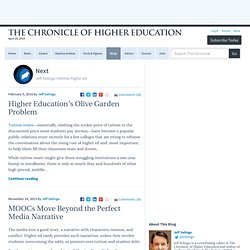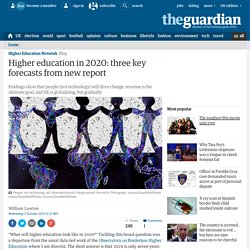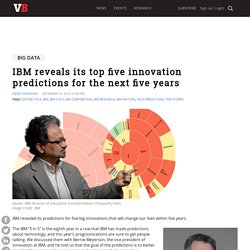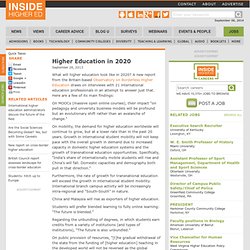

IT_Strategy_Made_Simple.pdf. The Big Lie of Strategic Planning. All executives know that strategy is important.

But almost all also find it scary, because it forces them to confront a future they can only guess at. Worse, actually choosing a strategy entails making decisions that explicitly cut off possibilities and options. An executive may well fear that getting those decisions wrong will wreck his or her career. The natural reaction is to make the challenge less daunting by turning it into a problem that can be solved with tried and tested tools. 7 Simple Steps In Strategic Planning Process. Does Your Business Need a Vision? - Robert Stover. Media//Files/Reports/2012/PIP_Future_of_Higher_Ed.pdf.
Next - Blogs. Tuition resets—essentially, slashing the sticker price of tuition to the discounted price most students pay anyway—have become a popular public-relations stunt recently for a few colleges that are trying to reframe the conversation about the rising cost of higher ed and, most important, to help them fill their classroom seats and dorms.

While tuition resets might give those struggling institutions a one-year bump in enrollment, there is only so much they and hundreds of other high-priced, middle… The media love a good story, a narrative with characters, tension, and conflict. Higher ed rarely provides such narratives, unless they involve students overcoming the odds, or protests over tuition and student debt.
For the past two years, the subject of Massive Open Online Courses, or MOOCs, has delivered a compelling narrative about the future of higher ed, at a time when many colleges were struggling to maintain enrollments and stabilize their finances. MOOCs reimagined the online course fro… What Higher Education Will Look Like In 2020. Higher education is rapidly changing--you don’t have to even be paying much attention to see that.

Universities have started streaming lectures en masse, schools like Harvard and MIT are teaming up to create content tailored for the web, startups like UniversityNow are creating reasonably priced online universities, and startups like Udacity offer online-only classes from renowned professors. None of this existed 10 years ago, and the field isn’t done changing yet. A new report from Pew Internet looks at what higher education will look like in 2020, based on survey responses from over 1,000 "Internet experts, researchers, observers and users. " Below, highlights from the survey, including notable responses from those who were polled. Media//Files/Reports/2012/PIP_Future_of_Higher_Ed.pdf. Higher education in 2020: three key forecasts from new report.
"What will higher education look like in 2020?

" Tackling this broad question was a departure from the usual data-led work of the Observatory on Borderless Higher Education where I am director. The short answer is that 2020 is only seven years away and, with a bit of luck, things should not get much worse. The approach of our recent Horizon Scanning report for the International Unit and Leadership Foundation for Higher Education was dictated partly by the current landscape of higher education and further shaped by judgement. Its frame of reference included transnational education (TNE), Moocs, and ongoing debates around the sustainability of recruitment and international mobility. Other contributing factors were funding, student trends, trade liberalisation and the role of international rankings.
The paper concludes with a note on disruptive political change – while intended to be relevant to planning and policy decisions, it is descriptive and analytical rather than prescriptive. Microsoft Vision of the Classroom of the Future. IBM reveals its top five innovation predictions for the next five years. IBM revealed its predictions for five big innovations that will change our lives within five years.

The IBM “5 in 5” is the eighth year in a row that IBM has made predictions about technology, and this year’s prognostications are sure to get people talking. We discussed them with Bernie Meyerson, the vice president of innovation at IBM, and he told us that the goal of the predictions is to better marshal the company’s resources in order to make them come true. “We try to get a sense of where the world is going because that focuses where we put our efforts,” Meyerson said.
“The harder part is nailing down what you want to focus on. Unless you stick your neck out and say this is where the world is going, it’s hard to you can turn around and say you will get there first. From VentureBeat Location, location, location — Not using geolocation to reach your mobile customers? (See our complete interview with Meyerson here). In a nutshell, IBM says: The classroom will learn you Powered by VBProfiles. Star Trek 2009 Vulcan School. Home. 10 megatrends affecting corporate IT through 2020. Future of Higher Education. College 2020: Higher Education and the Online 2.0 Institutions. Abstract.

Higher Education in 2020. What will higher education look like in 2020?

A new report from the Britain-based Observatory on Borderless Higher Education draws on interviews with 21 international education professionals in an attempt to answer just that. Here are a few of its main findings: On MOOCs (massive open online courses), their impact “on pedagogy and university business models will be profound but an evolutionary shift rather than an avalanche of change.” On mobility, the demand for higher education worldwide will continue to grow, but at a lower rate than in the past 20 years. Growth in international student mobility will not keep pace with the overall growth in demand due to increased capacity in domestic higher education systems and the growth of transnational education opportunities. Furthermore, the rate of growth for transnational education will exceed the growth in international student mobility.
Www.nmc.org/pdf/2013-horizon-report-HE.